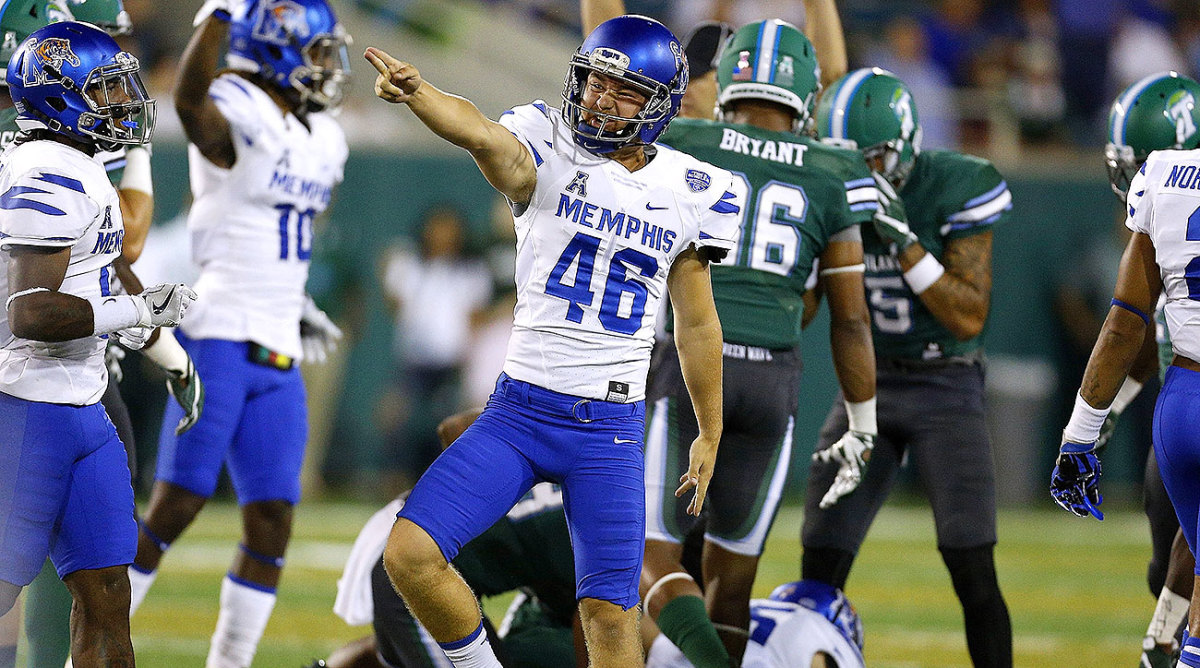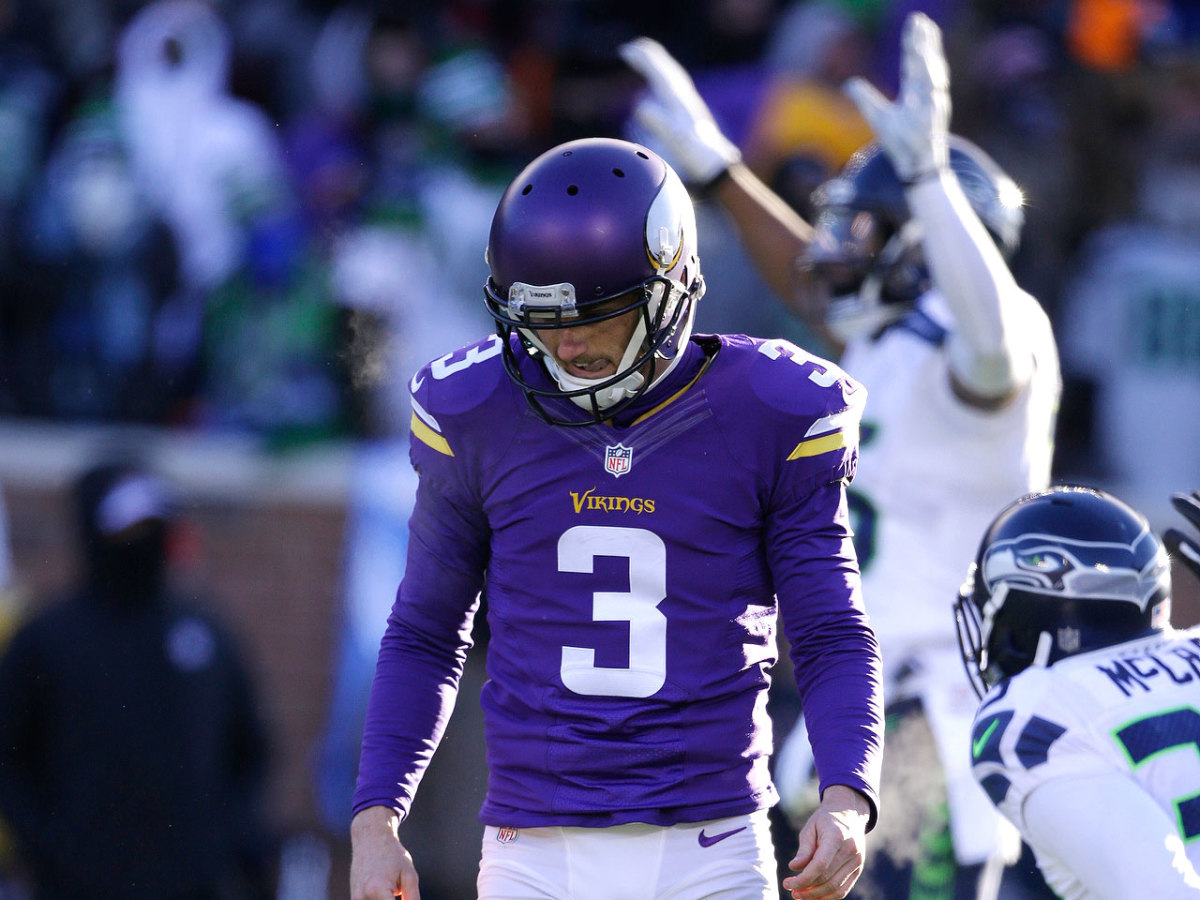The placekicker puzzle: Why it's one of the toughest positions for NFL scouts to evaluate

INDIANAPOLIS — Early into pro football’s optimism season, a personnel executive who works for an NFC playoff team stops inside a convention center hallway. “I’m not sure if this makes sense. You wouldn’t necessarily think of that position in this way,” he says. “It might not be the most important position we evaluate. But it’s one of the most difficult positions to evaluate.”
The executive stops and shakes his head. “It’s difficult,” he says, adding a “really” to emphasize he’s being serious.
He’s not talking about finding a franchise quarterback, an elite pass rusher or even a regular offensive or defensive starter. He’s talking about the process of discovering kickers, of which there were four among 330 pro hopefuls at the NFL Scouting Combine. Their legs can kick teams into or out of the playoffs. They can seal Super Bowl wins. Or miss attempts that end seasons. Or cost personnel executives their jobs.
What’s odd and difficult about kickers and how NFL teams evaluate them is that every off-season, so much money and time is spent measuring everything from a prospect’s height to his background to his intelligence. But what franchises cannot measure is what separates a kicker with NFL leg strength from a kicker with NFL leg strength who can also withstand the psychological quagmire inherent to that position. They cannot, in other words, measure what goes on—and what will go on—inside a kicker’s brain.
NFL free agency grades: Analyzing the biggest moves of the new league year
Take Roberto Aguayo, for example. Before he entered the 2016 NFL draft, he converted 96.7% of his overall attempts at Florida State, the best rate in college football history. He was close to automatic as one can get in placekicking. He didn’t miss one kick inside 40 yards. He didn’t botch a single extra point. When Tampa Bay traded up to select Aguayo with a second second-round pick last spring, the move seemed to make sense—or as much sense as drafting a kicker in the second round can make.
Aguayo missed a field goal in Week 2, another in Week 3, two more in Week 5 and another in Week 6. He botched two extra points. He finished the season with 22 makes in 31 attempts, good for a conversion rate of 71%, or 26% worse than he kicked in college. That isn’t to say the Bucs made the wrong move, or that Aguayo won’t have a long, storied, Pro Bowl-type career. That’s only to say that with kickers in particular there is no such thing as a sure thing.
“Kicking is mostly mental,” says Michael Husted, who kicked for four teams, including the Bucs, over nine NFL seasons and now works as a personal kicking coach. “Whether [Aguayo] wants to admit it or not, there’s pressure with being that high of a draft pick. It could even be subconscious.”
Husted then points to a kicker he has worked with, Wil Lutz, who went undrafted out of Georgia State, signed with the Ravens before the 2016 season and performed well in practice. The Ravens cut him but recommended him to the Saints, and Lutz became the New Orleans kicker last season. He went 28 for 34 on field goals, good for an 82.4% success rate.
In an unprecedented trade, Texans send Brock Osweiler and his huge contract to the Browns
“It’s all relative,” Husted says. “The Patriots took Stephen Gostkowski in the fourth round [in 2006]. He has had an amazing career. But so did Robbie Gould. He was a 60% field goal kicker at Penn State.” (Gould made 63.9% of his college field goal attempts.)
Husted is right. Of the three kickers drafted in the fourth round or earlier since 2006, Aguayo stumbled, Alex Henery (fourth round, Eagles) lasted four seasons and Gostkowski remains with the Patriots, although he uncharacteristically struggled last season. Meanwhile, of the five kickers with the best conversion rates in ’16 (minimum 20 attempts)—Baltimore’s Justin Tucker, Atlanta’s Matt Bryant, Tennessee’s Ryan Succop, Seattle’s Steven Hauschka and Kansas City’s Cairo Santos—four went undrafted. Only Succop heard his name called … by the Chiefs … in ’09 … with the 256th pick.
There it was: a kicker as Mr. Irrelevant.

Here’s how kickers are currently evaluated at the combine: They’re measured for height and weight; they meet with teams for interviews, with special teams coordinators serving as foreign language translators; and they attempt between 14 and 20 kicks. That’s it.
At this year’s combine, Memphis kicker Jake Elliott ran an unofficial 4.68-second 40-yard dash to display his athleticism. Stanford kicker Conrad Ukropina made all 15 of his attempts. And Zane Gonzalez of Arizona State did nothing to diminish his status as the NFL’s top kicking prospect, after winning the Lou Groza Award for the nation’s best kicker in 2016 and setting all-time FBS kicking records for career field goals made (96) and points scored (494).
The teams evaluated those players—along with Harrison Butker of Georgia Tech—the best they could. They looked for some of the same things that John Carney, a 23-year NFL veteran, uses to evaluate prospects at the kicking academy he named after himself. He watches their warmup, looking for calculated routines and intensity. He examines the flight of their kicks to gauge consistency. Are the heights different? The trajectories?
2017 NFL draft rankings: Top prospects by position
The automatic kickers tend to resemble the smoothest golfers in that their moneymaking motions are fluid, devoid of unnecessary movement, repeatable and compact. The less jerky the motion, the less elongated—think hitting a nine-iron compared to driver—the easier their kicks are to control.
“I always tell clients, in the NFL consistency is king,” Carney says. He watches to see if kickers follow through the same way after each attempt, if they keep their heads down, if they have any quirks—and how they explain them. He watches how they respond to misses, even in practice. He pays particular attention to their game film from pressure situations—how they kicked at the end of halves or games, how they performed in important contests, how they reacted to shanked kicks and, most importantly, how they performed immediately after them.
“There’s a lot to it,” Carney says. “But there’s so much more they don’t look at. Some scouts and coaches just look at the results on that day. He made eight out of 10 field goals. I like him!
“That’s one of the issues.”
On Nov. 20 last season—Week 11—NFL kickers combined to miss a record 12 extra points. Sure, the league had moved the line of scrimmage for point-after attempts from the two-yard-line to the 15-yard-line in 2015. But 12 misses? Twelve?
Shank Sunday spoke to the difficulty in both kicking and evaluating kickers. It’s impossible to say for sure that all or even most of those players suffered a collective psychological breakdown. That on the same day, unaware of each other’s misses, they all suffered mental lapses in the same afternoon.
But Husted also offers a one-name explanation: Blair Walsh. He was the Vikings’ kicker for more than four seasons and a reliable one (career field goal percentage: still 84.2) until he mis-hit a gimme 27-yarder that would have beaten the Seahawks in the first round of the playoffs. That game was the third-coldest in NFL history, and Walsh’s holder went all Ace Ventura and pointed the laces pointed inward, and when Walsh’s foot caught the laces, the attempt shot left. None of that mattered. The worst people on social media threatened Walsh’s life.
No matter what he said, all the usual kicker speak like moving on and same approach and I’m past it, the psychological impact carried into the 2016 season. Walsh missed four field goals in Minnesota’s first nine games, including two in the opener. He botched four extra points. Then the Vikings released him on Nov. 15 and the next Sunday … NFL kickers missed 12 extra points. Can anyone draw a firm conclusion that Walsh’s release impacted his kicking compadres? Of course not.
But it’s also one hell of a coincidence.

That’s the thing about kickers. They’re isolated in practice, and they stand alone in games, and then they’re summoned onto the field in front of packed stadiums and drunk crowds to kick an oblong leather ball through two long metal poles wrapped in yellow padding. If they make game winners, they will be noted but not nearly as much as the star quarterback or the shutdown corner. If the miss, it will be, simply, all their fault. This is a lonely, quarantined existence for athletes who are indispensable in crucial moments but dispensable the rest of the year.
That has led some kickers, like the 12-year NFL veteran Billy Cundiff to seek out mental trainers, or sports psychologists. One of his coaches suggested that approach to Cundiff back in 2006, after he struggled in a brief five-game stint with New Orleans. He didn’t play for the next two seasons but did start working with Dr. Louis Csoka of Apex Performance. Cundiff worked back into the NFL in 2009. He made the Pro Bowl in 2010. “He helped me deal with the pressure of the game,” Cundiff says. “He’d say, listen, this isn’t about how you feel. This isn’t some California hot-tub bull----. This is science! This is about physiological responses and learning to deal with them.”
The combine, Cundiff says, doesn’t measure the mental side of a kicker’s job the way that Csoka measured his ability to respond to pressure and deal with stress, improving both. Because NFL teams do little to try and evaluate that, “I don’t know if you’ll ever be able to measure with any high degree of certainty whether a kicker will be successful in the league,” Cundiff says. “That’s why so many guys slip through the cracks.”
With the combine behind us and NFL free agency in full swing, teams are piecing together their 2017 rosters, looking at every position from quarterbacks all the way down to kickers. (Chandler Catanzaro and Robbie Gould have made headlines since the league’s new year started, signing with new teams.) And Dr. Amy Bair, a performance trainer at Apex who works with everyone from business executives to CEOs to combat veterans, thinks NFL teams could better evaluate the kicking position, using many of the same techniques Apex uses in its diagnostics.
Teams could, for instance, ask prospects to fill out the same personality evaluations as Navy Seals, where the questions are designed to show who will thrive in a high-trust, high-risk, high-performance environments. They could also introduce pressure scenarios. Like, for instance, showing hopefuls videos of Walsh’s missed kick, or montages of mishits, and then have experts like Bair in body language gauge how they respond. Does their heart-rate increase? Can they control their breathing? How do they process that information?
“The brain is so powerful that if they’re watching those videos that will take them back to their own moments and they’ll be able to re-imagine what’s going on,” Bair says. “That’s how you assess how they’ll react in similar situations in real life. The goal is to find consistency in whatever scenario they’re in. They can’t necessarily control how they respond. But it’s how they react to that response.”
NFL scouts on the prospects who impressed—and disappointed—at this year's combine
Even those assessments won’t guarantee that NFL franchises can pinpoint which kickers with similar leg strength and technique will succeed or fail. But it’s a start for teams that measure everything they can at the combine but with kickers find that there is one thing they cannot measure—the brain, and how it will respond to failure. Their seasons, jobs, jobs, legacies—all of that may depend on what’s at best now unscientific guess work.
“Tell them to call me,” Bair says.
